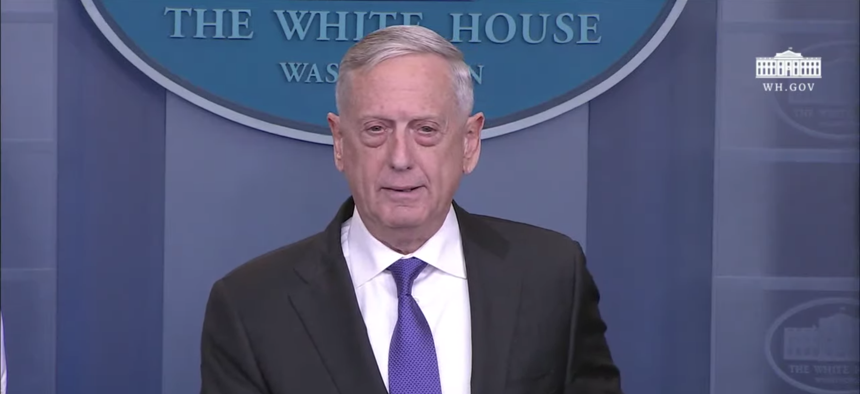
Defense Secretary James Mattis speaking at the White House Briefing Room, Feb. 7, 2017. Screengrab via WH.gov
Two-Year Budget Deal Would Raise Caps, Give Pentagon $700B in 2018
The deal comes with a new continuing resolution to give House and Senate lawmakers time to work out details.
Senators struck a budget deal Wednesday that would provide steep increases in U.S. defense spending over the next two years — up more than 15 percent in 2018 alone, the largest boost in more than a decade and a half.
The full agreement remains to be hammered out between the House and Senate, but Defense Secretary James Mattis pronounced himself “very happy with $700 [billion] for this year, and $716 [billion] for next.”
Those numbers appear to be the rough totals of base and overseas contingency operations funding. Under the deal, lawmakers’ aides told the New York Times, base funding would be about $80 billion higher than the $549 billion limit set by the 2011 Budget Control Act — that is, about $629 billion. They also said that in 2019, the base would top the caps by $85 billion. And the deal reportedly includes $140 billion in war funding, which is not subject to BCA caps, split between the two years.
White House Press Secretary Sarah Sanders also appeared to confirm that 2018 spending would be in the rough area of $700 billion. “Defense spending will match the request made by the Pentagon and will reflect what the president signed into law with the National Defense Authorization Act,” Sanders told reporters Wednesday. The 2018 NDAA, which was signed about two months ago, authorizes spending of $693 billion.
Talking to reporters at the same White House press conference, Mattis hailed the deal as a must-pass agreement.
“For too long, we have asked our military to carry on stoically with a ‘success at any cost’ attitude,” said the secretary, who was the only Cabinet-level official rolled out after news of the deal broke. “We need Congress to lift the defense spending caps and support a two-year budget agreement for our military. America can afford survival.”
As did defense leaders on the Hill. Sen. John McCain and Rep. Mac Thornberry, the chairmen of the two Armed Services Committee released a joint statement backing the agreement.
“This budget agreement is indispensable for our national security,” they said. “After nearly a decade of asking our troops to do more with less, we hope this agreement will allow the military to begin to rebuild and ensure that process can continue into next year.”
The deal would increase defense spending nearly $100 billion in 2018, a more-than-15 percent increase over 2017 base-plus-OCO spending. It’s the largest year-over-year increase to the Pentagon’s budget since it jumped more than 25 percent in 2003, when hundreds of thousands of U.S. troops were deployed to Iraq and Afghanistan.
Even though the deal’s broad strokes appear to have won the 60 Senate votes needed to lift the spending caps, many details about specific appropriations remain to be settled. A six-week continuing resolution, already passed by the House, would give appropriators time to do so.
A multi-year deal is something Mattis and other Pentagon officials have beseeched Congress for. After years of uncertainty and continuing resolutions, they say, a long-term funding agreement will give them the ability to rebuild readiness and invest in new weapons and platforms.
Budget uncertainty “hangs over you like a cloud,” Gen. Robert Neller, the commandant of Marine Corps, said two weeks ago. “The amount of money is important, but it’s probably not as important as having a budget — a budget that’s going to go beyond the end of the fiscal year.”
Along with the proposed defense hike, the budget deal adds $63 billion and $68 billion for non-defense discretionary spending over the next two years. Since, some House conservatives are already saying they won’t vote for the Senate deal, it will likely require Democratic support to pass the lower chamber.
Assuming it passes, what does the Pentagon plan to do with the extra money? Name a priority from the National Defense Strategy or service leaders’ talking points of the last few years, and it’s probably in there.
“Driven by this strategy, next week you will see in our FY19 budget investments the following: space and cyber, nuclear deterrent forces, missile defense, advanced autonomous systems, artificial intelligence, and professional military education to provide our high-quality troops what they need to win,” Mattis told the House Armed Services Committee yesterday. “We will prioritize rebuilding readiness while modernizing our existing force.”
In December, Deputy Defense Secretary Pat Shanahan cautioned that Trump’s promised military buildup might not occur until the 2020 budget because the administration hadn’t yet finalized its guiding strategic documents.
“[Fiscal year] '19 is a step up,” he said. “But, when you think about threading the National Defense Strategy into the details of the POM [an internal DoD six-year spending plan], you'll see it much more...in POM-20.”
Next week, the Pentagon is expected to send to Congress its spending request for 2019. Mattis recently confirmed the request would total $716 billion, which includes the Pentagon’s base and war budgets, as well as nuclear-weapons spending by the Energy Department. The Washington Post first reported the budget number.
NEXT STORY: How the Nunes Memo Harms Intelligence Oversight



